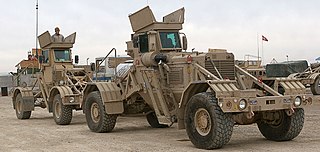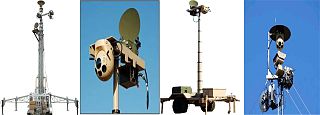
An improvised explosive device (IED) is a bomb constructed and deployed in ways other than in conventional military action. It may be constructed of conventional military explosives, such as an artillery shell, attached to a detonating mechanism. IEDs are commonly used as roadside bombs, or homemade bombs.

Dream Chaser is an American reusable lifting-body spaceplane developed by Sierra Space. Originally intended as a crewed vehicle, the Dream Chaser Space System is set to be produced after the Dream Chaser Cargo System cargo variant is operational. The crewed variant is planned to carry up to seven people and cargo to and from low Earth orbit.

Insurgency weapons and tactics (IWAT) are weapons and tactics, most often involving firearms or explosive devices, intended for use by insurgents to engage in guerrilla warfare against an occupier, or for use by rebels against an established government. One type of insurgency weapon are "homemade" firearms made by non-professionals, such as the Błyskawica (Lightning) submachine gun produced in underground workshops by the Polish resistance movement. Another weapon that is part of the conventional military arsenal, but which has been taken up to great effect by insurgents, is the RPG. Two examples of an improvised weapon used by insurgents would be the improvised explosive devices used in Iraq and the Molotov cocktails used against vehicles and tanks. Two tactics used by many insurgents are assassinations and suicide bomb attacks. The latter tactic is used when an insurgent has a bomb strapped to them or in their car, which provides a low-tech way for insurgents to get explosives close to critical enemy targets.

The LAV III is the third generation of the Light Armoured Vehicle (LAV) family of armored personnel carriers built by General Dynamics Land Systems – Canada (GDLS-C), a London, Ontario, based subsidiary of General Dynamics. It first entered service in 1999, succeeding the LAV II. It is the primary mechanized infantry vehicle of both the Canadian Army and the New Zealand Army. It also forms the basis of the Stryker vehicle used by the U.S. Army and other operators. The Canadian Army is upgrading its LAV IIIs to the LAV 6 standard. Early in its development history it was referred to as the 'Kodiak', but the name was never officially adopted.

The TM 31-210 Improvised Munitions Handbook is a 256 page United States Army technical manual intended for the United States Army Special Forces. It was first published in 1969 by the Department of the Army.

Naval Surface Warfare Center Crane Division is the principal tenant command located at Naval Support Activity Crane in Indiana.

The Husky VMMD is a configurable counter-IED MRAP vehicle, developed by South African-based DCD Protected Mobility and American C-IED company Critical Solutions International. Designed for use in route clearance and de-mining operations, the Husky is equipped with technologies to help detect explosives and minimise blast damage.

The Joint Improvised-Threat Defeat Organization (JIDO) is a combat support organization of the U.S. Department of Defense (DoD) organization under the Defense Threat Reduction Agency (DTRA) that deals with improvised threats such as the improvised explosive device (IEDs) and small unmanned aerial systems (sUASs). JIDO was born from the Joint IED Defeat Organization (JIEDDO) established in 2006, which focused on IEDs. JIDO's mission is to "enable Department of Defense actions to counter improvised threats with tactical responsiveness and anticipatory acquisition in support of combatant commanders' efforts to prepare for, and adapt to, battlefield surprise." This mission supports counter-terrorism, counter-insurgency and other related mission areas including Counter-IED.
Sierra Nevada Corporation is an American aerospace, defense, electronics, engineering and manufacturing corporation that specializes in aircraft modification, integration and other space technologies. The corporation contracts with the United States Armed Forces, NASA, and private spaceflight companies. The corporation is headquartered in Sparks, Nevada, and has 36 locations in the United States, United Kingdom, Germany, and Turkey.

The Fleet Electronic Warfare Center (FEWC) is a subordinate organization of the Naval Network Warfare Command (NNWC), which was established in 2008 to be the center for US Navy fleet electronic warfare (EW) operational and tactical issues. It is currently located at Navy Information Dominance Forces (NIDF) Headquarters, in Suffolk, VA as an independent directorate.

USSS Electronic Countermeasures Suburban is the United States Secret Service Electronic Counter Measures Chevrolet Suburban, an element of a United States presidential motorcade or vice-presidential motorcade.

Counter-IED efforts are done primarily by military and law enforcement with the assistance of the diplomatic and financial communities. It involves a comprehensive approach of countering the threat networks that employ improvised explosive devices (IEDs), defeating the devices themselves, and training others. Counter-IED, or C-IED, is usually part of a broader counter-terrorism, counter-insurgency, or law enforcement effort. Because IEDs are a subset of a number of forms of asymmetric warfare used by insurgents and terrorists, C-IED activities are principally against adversaries and not only against IEDs. C-IED treats the IED as a systemic problem and aims to defeat the IED threat networks themselves.

Counter-IED equipment are created primarily for military and law enforcement. They are used for standoff detection of explosives and explosive precursor components and defeating the Improvised Explosive Devices (IEDs) devices themselves as part of a broader counter-terrorism, counter-insurgency, or law enforcement effort.

The Ground-Based Operational Surveillance System, (G-BOSS) created by Raytheon Integrated Defense Systems, is a trailer-mounted tower with mounted surveillance systems. It was integrated with the command operations center (COC) used primarily by the United States Marine Corps during the War in Afghanistan (2001-2021) and the War in Iraq. The G-BOSS is used primarily for force protection, checkpoint security, route reconnaissance, patrol over watch, improvised explosive devices emplacement detection, intelligence gathering, and personnel/vehicle identification.

The Krasukha is a Russian mobile, ground-based, electronic warfare (EW) system. This system is produced by the KRET corporation on different wheeled platforms. The Krasukha's primary targets are airborne radio-electronics and airborne systems guided by radar. The Krasukha has multiple applications in the Russian Armed Forces.
Combined Joint Task Force Paladin was the International Security Assistance Force command responsible for counter-IED efforts and Explosive Ordnance Disposal (EOD) during the War in Afghanistan (2001–2021). With military and civilian personnel spread across the entire country, CJTF Paladin provided EOD Technicians, counter-IED trainers, intelligence personnel, and forensics labs to the ISAF Regional Commands.

The Ordnance Corps (ORD) is a combat support corps of the Irish Army, a branch of the Defence Forces, that has logistical and operational responsibility for military ordnance in Ireland. The logistical role of the Army Ordnance Corps is to provide technical support to the Defence Forces for the procurement, storage, distribution, inspection, maintenance, repair and disposal of all items of ordnance equipment. The operational role of the Ordnance Corps is to train personnel for and provide the state's bomb disposal capability.
The Improvised Explosive Device Countermeasure Equipment (ICE) is a vehicle-mounted electronics-based jamming system that uses low-power radio frequency energy to thwart enemy improvised explosive devices (IEDs). The radio frequency energy it emits blocks the signals broadcast by radio-controlled detonators, such as cell phones and cordless telephones, that would otherwise trigger the hidden IED to explode. ICE was developed by the Army Research Laboratory (ARL) at White Sands Missile Range and the Physical Science Laboratory (PSL) at New Mexico State University in 2004 to counter the rising IED threat in Iraq. Due to the urgent demand for counter-IED equipment, ICE was designed and built within three weeks and was provided to troops in less than six months after the project started.














